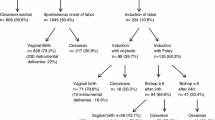Abstract
Purpose
Cesarean deliveries of multiple pregnancies are associated with a high risk of hemorrhage. The aim of this study is to evaluate the efficacy of carbetocin administered systematically during cesarean deliveries of multiple pregnancies.
Methods
Single-center retrospective before-and-after study comparing the use of carbetocin to that of oxytocin during cesareans during two consecutive 6-month periods. A composite variable was predefined as the principal endpoint: any one or more of bleeding ≥1,500 mL, transfusion, hemoglobin reduction of 4 g/dL or more or operative intervention (surgery, embolization).
Results
In an intention-to-treat analysis, the comparison of the two groups (n = 24 before and n = 39 after) showed no difference for the occurrence of the composite variable (16.7 vs. 15.4 %, p = 0.89). Nor did the per-protocol analysis (n = 24 before and n = 27 after) differ for it (16.7 vs. 14.8 %, p = 0.86). Moreover, none of the secondary outcome measures studied—moderate blood loss, prescription of sulprostone, cell-saver use, and intravenous iron infusion—differed significantly between the two periods.
Conclusion
In our population of multiple pregnancies delivered by cesarean, carbetocin did not appear more effective than oxytocin in preventing severe postpartum hemorrhage.

Similar content being viewed by others
References
International joint policy statement (2004) FIGO/ICM global initiative to prevent postpartum hemorrhage. J Obstet Gynaecol Can 26(12):1100–2,8–11
Goffinet F (2000) Hemorrhage during delivery. Gynecol Obstet Fertil 28(2):141–151
Gilbert L, Porter W, Brown VA (1987) Postpartum haemorrhage: a continuing problem. Br J Obstet Gynaecol 94(1):67–71
Subtil D, Somme A, Ardiet E, Depret-Mosser S (2004) Postpartum hemorrhage: frequency, consequences in terms of health status, and risk factors before delivery. J Gynecol Obstet Biol Reprod 33(8):4S9–4S16
Bouvier-Colle MH, Saucedo M, Deneux-Tharaux C (2011) The confidential enquiries into maternal deaths, 1996–2006 in France: what consequences for the obstetrical care? J Gynecol Obstet Biol Reprod 40:87–102
CNGOF (2004) Post-partum hemorrhage. Guidelines (short text). J Gynecol Obstet Biol Reprod 33(Suppl. no 8):4S130–4S136
Rath W (2009) Prevention of postpartum haemorrhage with the oxytocin analogue carbetocin. Eur J Obstet Gynecol Reprod Biol 147(1):15–20
Wedisinghe L, Macleod M, Murphy DJ (2008) Use of ocytocin to prevent haemorrhage at caesarean section-a survey of practice in the United Kingdom. Eur J Obstet Gynecol Reprod Boil 137:27–30
Engstrom T, Barth T, Melin P, Vilhardt H (1998) Oxytocin receptor binding and uterotonic activity of carbetocin and its metabolites following enzymatic degradation. Eur J Pharmacol 355(2–3):203–210
Su LL, Chong YS, Samuel M (2007) Oxytocin agonists for preventing postpartum haemorrhage. Cochrane Database Syst Rev 18(3):CD005457
Reyal F, Deffarges J, Luton D, Blot P, Oury J-F, Sibony O (2002) Severe post-partum hemorrhage: descriptive study at the Robert-Debré Hospital maternity ward. J Gynécol Obstet Bio Reprod 31(4):358–364
Waterstone M, Bewley S, Wolfe C (2001) Incidence and predictors of severe obstetric morbidity: case-control study. BMJ 322:1089–1094
Boucher M, Horbay GLA, Griffin P et al (1998) Double-blind, randomized comparison of the effect of carbetocin and oxytocin on intraoperative blood loss and uterine tone of patients undergoing cesarean section. J Perinatol 18:202–207
Dansereau J, Joshi AK, Helewa ME et al (1999) Double-blind comparison of carbetocin versus oxytocin in prevention of uterine atony after cesarean section. Am J Obstet Gynecol 180:670–676
Attilakos G, Psaroudakis D, Ash J et al (2010) Carbetocin versus oxytocin for theprevention of postpartum haemorrhage following caesarean section: the results of a double-blind randomised trial. Br J Obstet Gynaecol 117:929–936
Borruto F, Treisser A, Comparetto C (2009) Utilization of carbetocin for prevention of postpartum hemorrhage after cesarean section: a randomized clinical trial. Arch Gynecol Obstet 280:707–712
Triopon G, Goron A, Agenor J et al (2010) Use of carbetocin in prevention of uterine atony during cesarean section. Comparison with oxytocin. Gynécol Obstet Fertil 38:729–734
Conflict of interest
D. Subtil is a member of the board of directors of the FERRING® laboratory, which markets carbetocin in France (PABAL®).
Author information
Authors and Affiliations
Corresponding author
Rights and permissions
About this article
Cite this article
Julie, D., Elodie, C., Anne, D. et al. Systematic use of carbetocin during cesarean delivery of multiple pregnancies: a before-and-after study. Arch Gynecol Obstet 287, 875–880 (2013). https://doi.org/10.1007/s00404-012-2646-2
Received:
Accepted:
Published:
Issue Date:
DOI: https://doi.org/10.1007/s00404-012-2646-2




